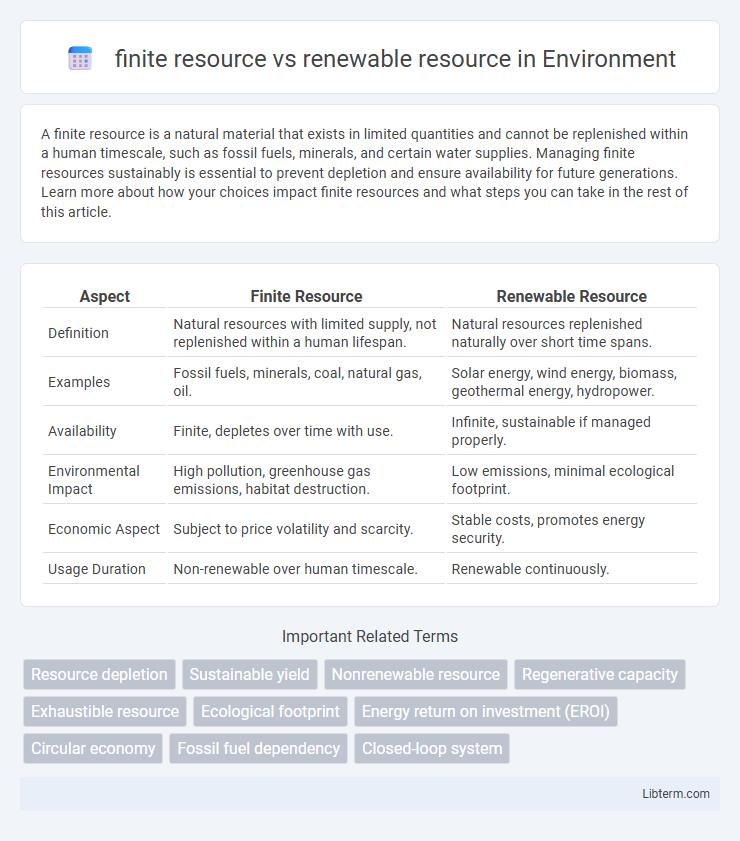A finite resource is a natural material that exists in limited quantities and cannot be replenished within a human timescale, such as fossil fuels, minerals, and certain water supplies. Managing finite resources sustainably is essential to prevent depletion and ensure availability for future generations. Learn more about how your choices impact finite resources and what steps you can take in the rest of this article.
Table of Comparison
| Aspect | Finite Resource | Renewable Resource |
|---|---|---|
| Definition | Natural resources with limited supply, not replenished within a human lifespan. | Natural resources replenished naturally over short time spans. |
| Examples | Fossil fuels, minerals, coal, natural gas, oil. | Solar energy, wind energy, biomass, geothermal energy, hydropower. |
| Availability | Finite, depletes over time with use. | Infinite, sustainable if managed properly. |
| Environmental Impact | High pollution, greenhouse gas emissions, habitat destruction. | Low emissions, minimal ecological footprint. |
| Economic Aspect | Subject to price volatility and scarcity. | Stable costs, promotes energy security. |
| Usage Duration | Non-renewable over human timescale. | Renewable continuously. |
Understanding Finite and Renewable Resources
Finite resources, such as fossil fuels and minerals, are limited in supply and cannot be replenished within a human timescale, leading to eventual depletion and environmental concerns. Renewable resources, including solar energy, wind, and biomass, regenerate naturally and sustainably, offering long-term energy solutions without exhausting the Earth's capacity. Understanding the distinction between these resource types is crucial for developing efficient energy policies and promoting sustainable development.
Key Differences Between Finite and Renewable Resources
Finite resources, such as fossil fuels and minerals, are limited in supply and cannot be replenished within a human timeframe, leading to inevitable depletion. Renewable resources, including solar energy, wind, and biomass, regenerate naturally and sustainably, providing continuous availability when managed properly. The key difference lies in the regeneration rate and availability: finite resources face scarcity and environmental impact due to extraction, whereas renewable resources offer a sustainable alternative with lower ecological footprints.
Common Examples of Finite Resources
Finite resources, also known as non-renewable resources, include coal, petroleum, natural gas, and minerals like gold and uranium, all of which are limited in supply and deplete faster than natural processes can replenish them. These resources are essential for energy production, manufacturing, and industrial applications, but their extraction and consumption contribute to environmental degradation and climate change. In contrast, renewable resources such as solar energy, wind power, and biomass regenerate naturally, offering sustainable alternatives to finite resource dependence.
Popular Types of Renewable Resources
Popular types of renewable resources include solar energy, wind power, hydroelectric energy, biomass, and geothermal energy, all of which naturally replenish over time and have minimal environmental impact. Unlike finite resources such as coal, oil, and natural gas, these renewable sources provide sustainable alternatives to meet growing energy demands without depleting Earth's reserves. Increasing investments in solar panels, wind turbines, and bioenergy technologies highlight the global shift toward reducing carbon emissions and promoting energy security through renewable resources.
Environmental Impact of Resource Consumption
Finite resources, such as fossil fuels and minerals, cause significant environmental degradation through extraction processes that lead to habitat destruction, pollution, and greenhouse gas emissions. Renewable resources, including solar, wind, and biomass energy, offer a sustainable alternative by minimizing carbon footprints and reducing ecosystem disruption when managed responsibly. Overreliance on finite resources accelerates climate change and biodiversity loss, whereas investing in renewable resource technologies supports long-term ecological balance and resource availability.
Economic Implications of Resource Scarcity
Finite resources, such as fossil fuels and minerals, create economic challenges due to their limited availability, driving up extraction costs and market prices as depletion progresses. Renewable resources like solar and wind energy offer more sustainable economic opportunities by lowering long-term energy costs and reducing dependency on fluctuating commodity markets. Resource scarcity in finite materials leads to increased investment in innovation and alternative technologies, influencing global trade dynamics and economic stability.
The Role of Technology in Resource Management
Technology enhances resource management by improving efficiency and enabling sustainable use of both finite and renewable resources. Advanced monitoring systems and data analytics optimize extraction and reduce waste of finite resources like minerals and fossil fuels. For renewable resources, innovations in smart grids, precision agriculture, and renewable energy technologies ensure continuous regeneration and minimal environmental impact, promoting long-term sustainability.
Strategies for Sustainable Resource Use
Implementing efficient technologies and promoting resource recycling extend the lifespan of finite resources, reducing environmental impact and conserving reserves. Encouraging the development and integration of renewable energy sources like solar, wind, and biomass supports sustainable consumption and minimizes dependence on depleting finite resources. Policies that incentivize sustainable resource management and circular economy practices foster long-term ecological balance and economic resilience.
Challenges in Transitioning to Renewables
The transition from finite resources like fossil fuels to renewable resources faces significant challenges such as high initial infrastructure costs, intermittency issues with solar and wind energy, and the need for advanced energy storage solutions. Limited availability of rare earth metals essential for renewable technology production creates supply chain vulnerabilities. Policy uncertainties and the existing fossil fuel industry's economic influence further complicate the adoption of sustainable energy systems.
Future Outlook for Resource Sustainability
Finite resources such as fossil fuels and minerals face depletion risks due to increasing global demand, prompting urgent shifts toward renewable alternatives like solar, wind, and bioenergy. Advances in renewable technologies and energy storage are crucial for reducing carbon emissions and achieving long-term sustainability goals. Future resource management emphasizes circular economy principles, improved efficiency, and policy frameworks that support sustainable consumption and environmental preservation.
finite resource Infographic

 libterm.com
libterm.com